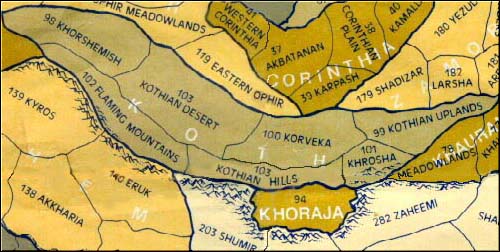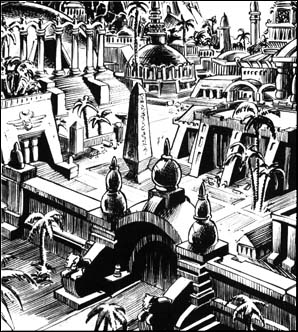
Koth

"Before midnight they crossed the Ophirean border and at dawn the spires of Khorshemish stood up gleaming and rose-tinted on the southeastern horizon, the slim towers overawed by the grim scarlet citadel that at a distance was like a splash of bright blood in the sky. (...) From the walls of the citadel one could look down on the broad white streets of the city, on minareted mosques, shops, temples and markets. One could look down, too, on the palaces of the king, set in broad gardens, high-walled, luxurious riots of fruit trees and blossoms, through which artificial streams murmured, and silvery fountains rippled incessantly. Over all brooded the citadel, like a condor stooping above its prey, intent on its own dark meditations." -- Robert E. Howard: "The Scarlet Citadel"


A Hyborian kingdom south of Ophir, Corinthia, and Zamora, North of Shem and Argos, and bordered on the east by Khoraja and Khauran.
The terrain of Koth is an exercise in geographical ingenuity. The steep peaks of the Karpash Range were an impassable barrier along the Corinthian border, as this area was not crossed by caravans. Further west, the mountains softened into hills below western Ophir, and were traversed by at least two passes. Along the Argossean frontier, the Pyrrhenian Mountains deflected moist air masses, creating Koth's western meadowlands (sub-humid prairie), fading into known deserts east of Khorshemish. This mountain range curved south, then to the east above Shem. It quickly faded into rugged hill-country, gaining elevation and impenetrability again at the Flaming Mountains, a volcanic range.
The important road going south out of Khorshemish traversed a pass on the way to Eruk in Shem. One thousand miles of uplands culminated in the Kothian Escarpment, a huge wall that ran along the edge of the Eastern Desert before rising into the southern bulk of the Kezankian Mountains. The eastern region of the kingdom is described as "fertile uplands". This presupposes that the hills south of Zamora acted as a moisture trap to water the region and fill its "blue lakes and rivers". It also makes necessary a basin-style drainage pattern for eastern Koth. A saline body of water in the barrens of central Koth called Salt Lake, together with additional smaller bodies of freshwater, took care of the runoff.
Koth has meadows and orchards in the western and farms in the eastern uplands. The anomalous desert of Koth, mentioned in Return of Conan, has been placed in the central kingdom.

Its ancient capital, Khorshemish, is the center of the armor-making industry that is Koth's pride and joy. Almost all scholars discussing Koth's history have presumed it to be the first of the Hyborian kingdoms. The geography of the world-continent and its effect on the movement of the early Hyborians makes such a hypothesis unlikely. Koth is very old, but it was probably not originally established by Hyborians. Valusian refugees are more plausible precursors.
In Hour of the Dragon, Howard says: "The barbarians (Hybori) who overthrew Acheron set up new kingdoms. Where the Empire had stretched now rose realms called Aquilonia, and Nemedia, and Argos, from the tribes that founded them. The older kingdoms of Ophir, Corinthia, and western Koth, which had been subject to the kings of Acheron, regained their independence with the fall of the Empire."
This is ambiguous, since it may be interpreted to mean that Ophir, Corinthia, and western Koth were independent contemporaneous with the early florescence of Acheron. If this were the case, the Hybori could hardly have dominated them. How would the Northerners have gotten there? Through Acheron? Through Zamora? Through Brythunia? One may also ask what happened to the populations of pre-Cataclysmic nations not chronicled in the Saga? Once in a while they get the short shrift as "aborigines" contributing their genes to better known groups; but may we not also assume that relict populations from Valusia, Thurania, and even Zaarfhana found refuge in the mountains of Ophir and Corinthia -- and in Koth itself -- rebuilding their shattered culture as the Hyborians were doing in the Far North. I think so. And their subsequent history would be tied to that of Old Stygia and, later, Acheron. After the Hyborian consolidated their positions in Nemedia and Aquilonia, they could have moved southward once more to take over the Mysterious Three.
The elephant-being, Yag-kosha, mentions Koth between Nemedia and Aquilonia as he speaks of ancient Hyborian kingdoms. On more secure historical ground, chroniclers report that Hyborians from Koth drove the Old Stygians out of the western meadowlands of Shem into the lands south of the Styx. The Kothic hosts had to withdraw to their ultimate borderline when Shemite city-states increased in power.
In Conan's time, Koth was constantly in the throes of civil war. Its king, described as "penurious", was involved with Ophir in a disastrous adventure against Conan's Aquilonia. After the Age of Conan, Koth became a vassal of Aquilonia. Still later, it was a battleground where rampaging Picts and Hyrkanian empire-builders warred "incessantly".
References: Hyborian Age I-II, Tower of the Elephant, Hand of Nergal, Shadows in the Moonlight, Black Colossus, Scarlet Citadel, Hawks over Shem, Witch Shall Be Born, Devil in Iron, Hour of the Dragon, Return of Conan, Conan the Great, et al.
- Population: 5,700,000
- Capital: Khorshemish (pop. 950,000 -- one-third of which are foreign slaves)
- Ruler: Emperor Strabonus
- Major cities: Krosha, Korveka
- Resources: Grain, fruit, pottery, iron, weapons
- Imports: Furs, slaves
- Allies: Ophir, Corinthia, Nemedia
- Enemies: Aquilonia, Khoraja
- Tech level: Roman
- Religion: Ishtar, Bel, Set
